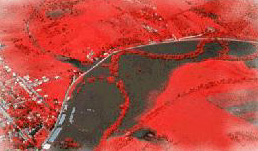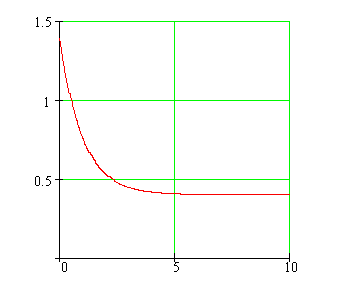
Resources
Math 3 Course Home Page
Math 3 Course Syllabus
Practice Exams
Textbook Home Page
Post a Comment
Contents
In this lecture we continue with the discussion of separable differential equations. We also consider exponential growth and decay, important models in real-world applications.
Quick Question
Is the town population depicted in the following graph, growing, decreasing, or staying the same over the last ten years?
Outline
Outlines forExponential Growth and Decay
Separable Differential Equations
Textbook
Exponential Growth and DecaySeparable Differential Equations
Today's Homework
Log into WebWorKQuiz
Exponential Growth and Decay QuizSeparable Differential Equations Quiz
Examples
-
 We have a 100-gallon tank filled with water. Saltwater is being pumped into the tank through two pipes. Write an equation which states how the amount of salt S is changing with respect to time, and use the differential equation from part 1 to write a function that states how much salt is present in the tank at a given time t.
We have a 100-gallon tank filled with water. Saltwater is being pumped into the tank through two pipes. Write an equation which states how the amount of salt S is changing with respect to time, and use the differential equation from part 1 to write a function that states how much salt is present in the tank at a given time t.
-
 A cup of coffee is initially 170 degrees Fahrenheit and is left in a room with ambient temperature 70 degrees Fahrenheit. Suppose that when the coffee is first placed in the room, it is cooling at a rate of 20 degrees per minute. Assuming Newton's law of cooling applies, how long does it take for the coffee to cool to 110 degrees?
A cup of coffee is initially 170 degrees Fahrenheit and is left in a room with ambient temperature 70 degrees Fahrenheit. Suppose that when the coffee is first placed in the room, it is cooling at a rate of 20 degrees per minute. Assuming Newton's law of cooling applies, how long does it take for the coffee to cool to 110 degrees?
-
 The population of fish in a pond is modeled by the differential equation dP/dt = 480 − 4P, where time t is measured in years. Towards what number does the population of fish tend? If there are initially 10 fish in the pond, how long does it take for the number of fish to reach 90% of the eventual population?
The population of fish in a pond is modeled by the differential equation dP/dt = 480 − 4P, where time t is measured in years. Towards what number does the population of fish tend? If there are initially 10 fish in the pond, how long does it take for the number of fish to reach 90% of the eventual population?
-
 Solve the differential equation dy/dx = xex2 − ln(y2)
Solve the differential equation dy/dx = xex2 − ln(y2)
-
 Solve the differential equation dy/dx = (x2y − 4y)/(x + 2)
Solve the differential equation dy/dx = (x2y − 4y)/(x + 2)
-
 Solve the differential equation x dy/dx = 2(y − 4)
Solve the differential equation x dy/dx = 2(y − 4)
Applets
Videos
 Radioactive decay in Earth Science determines approximate age of rocks (1)
Radioactive decay in Earth Science determines approximate age of rocks (1)
 Radioactive decay in Earth Science determines approximate age of rocks (2)
Radioactive decay in Earth Science determines approximate age of rocks (2)
 Separation of variables dP/dt = kP
Separation of variables dP/dt = kP
-
 Solving the basic population growth differential equation
Solving the basic population growth differential equation
-
 A Population of bacteria doubles every 2.5 hours. What equation governs its growth?
A Population of bacteria doubles every 2.5 hours. What equation governs its growth?
-
 "The Chafing Dish"
"The Chafing Dish"
-
 Solve the differential equation: dy/dx = (2x2 + 3x)/(y + 1)
Solve the differential equation: dy/dx = (2x2 + 3x)/(y + 1)

